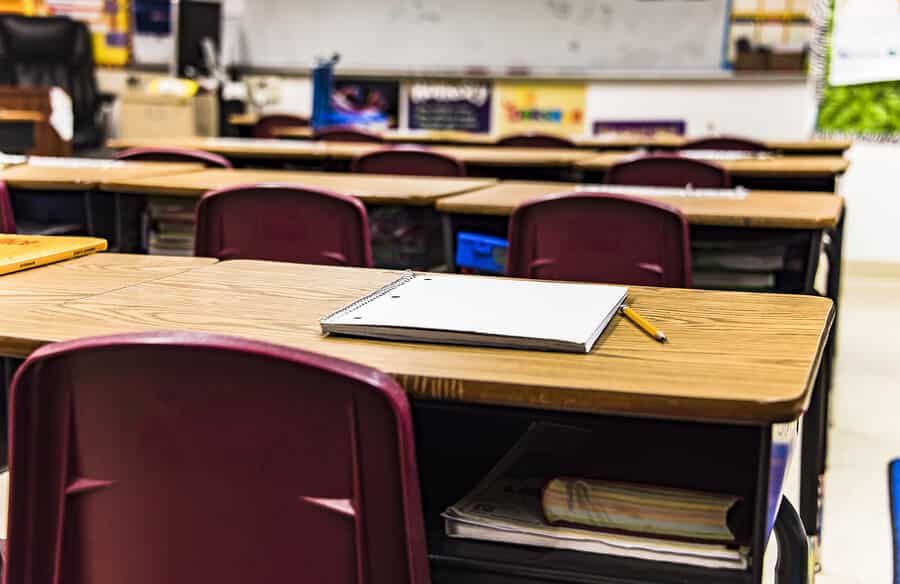
The Impact of Standing Desks in the School Classroom
When we discuss standing desks, our minds tend to jump straight to the workplace: corporate environments, both big and small, filled with passionate individuals supported by bosses and directors keen to improve the health, productivity, and job satisfaction of their team.
This week, we want to step back a few years to the place where kids spend 180 days (which equates to about 1000 hours) a year: school!

How long are kids really sitting for?
Kids need about 8 to 10 of sleep per night. So dismissing that, a regular school morning, day, and evening is made up of roughly 15 hours.
Let’s break it down further:
- 6 of those hours are spent in the classroom, sitting at desks or on the floor
- 30 minutes to an hour is spent getting to and from school – some may walk, but others will take public transport or are driven
- 1-2 hours is spent doing homework after school
- Leisure time in the evening can be anywhere from 1-3 hours – that means even more time sitting on the couch or at the dining table
It’s estimated that children spend up to 90% of their waking time in a sedentary position – setting the trend for obesity and instilling poor health habits from a worryingly early age.
This leads us into our next section: health problems children are facing, particularly in the classroom.
What health issues are affecting kids in the classroom?
Childhood obesity
It’d be impossible to write a list of health issues facing children today without addressing the childhood obesity epidemic.
Excess weight is directly linked to a direct risk of cardiovascular disease, diabetes, and even some cancers.
Shocking childhood obesity statistics
- 1 in 4 Australian children aged between 2 and 17 were overweight or obese in 2014-15
- The instance of type 2 diabetes in children and teens is continuing to rise
- Some research suggests that three times as many children are overweight or obese today compared to 30 years ago
Hyperactivity disorders
All children get restless and fidget, especially when having to sit for extended periods of time.
This is especially prevalent in classroom scenarios, where kids are expected to sit in the one spot for the duration of their class.
Fidgeting could be a normal behaviour. Or, it might in fact be a sign that your child could be exhibiting signs of an undiagnosed hyperactivity disorder like ADHD.
On the one hand parents might not want to make such seemingly grand gestures… but on the other, these signs could be a very clear warning that something serious is going on.
Either way, fidgeting can prove distracting to other kids in class, and disrupt learning.
Kids are getting taller…
… but desks aren’t getting bigger!
Ever noticed teens in their school uniform after school, and noticed how much they tower over you? When did that happen?! Kids seem to be growing taller by the day.
You’re not imagining it: over the past 150 years, our average height has climbed 15cm!
Along with an increased instance of childhood obesity, kids are finding their desks are simply not able to accommodate them comfortably.
This can lead to not only concentration issues in the classroom, but deeper-seated confidence and self-esteem troubles, along with the fear or hesitation to speak up.
What might sound irritating as you read this is a permanent problem some kids face every single day.

Benefits of electric standing desks in the classroom
Now that we’ve identified three major issues impacting children in the classroom, we focus our attention on the vast benefits electric standing desks offer young ones throughout their education.
Increase blood circulation
When your blood is pumping harder, it’s bringing more oxygen to your brain. This allows you to feel more refreshed, focused, and alert for longer!
Burn more calories
Did you know that the simple action of incorporating standing into your day can increase your calorie-burning rate?
You burn about 50 calories more per hour, standing than you do sitting. Don’t think it sounds like much? Over time, it certainly adds up:
- Standing for a total of 3 hours of your workday burns an extra 150 calories per day
- In a working week, you’ve burnt an additional 750 calories
- Multiply that by 48 working weeks, and you’ve managed to burn an astonishing extra 30,000 calories in a year, simply by incorporating standing into your daily routine!
Relieves irritability and fidgeting
Standing instantly provides kids an outlet to exert some of their fidgeting “energy”.
Telling a student to sit still almost always results in a child who ends up fidgeting and wiggling. They then become a distraction in the classroom and impacting their own concentration.
Standing desks have proven to bridge this gap. They givechildren the freedom of movement – while standing – to consistently relieve irritation throughout the day.
Improve concentration
Students in an “active learning” classroom have been found to outperform students in a sedentary learning environment, according to a study in this article.
Who’s already using standing desks?
Vallecito Elementary School
This school, located in San Francisco’s Bay Area, is possibly the first school in the world to replace all their traditional desks with standing desks for students!
The idea came from parents Juliet and Kelly Starrett, who realised that they were speaking to corporate teams about the dangers of sitting, so why not take the same stand towards children’s health?
Blackie K-8 school
This school is located in a tiny town about an hour south-east of Calgary, Canada.
In addition to the use of standing desks and bikes, teachers also encourage kids to jog around the track to process information and think about an answer, and even hop-scotch their way through the corridors!
Joseph Lee School
This Boston school has introduced a host of equipment and accessories to better match students’ individual preferences.
As part of the Boston Public School system’s “21st Century Furniture Initiative”, the school now has inflatable ball chairs, wheeled monitors, swivel tables to accommodate left- and right-handed kids, and of course, standing desks.
Roebourne District High School
Closer to home, RDHS school, located in the Pilbara district about 800km west of Broome in Western Australia, is trialling 15 standing desks in their Grade 2 classroom.
Osteopath Peter Parker, who’s a part of the trial, says that while standing desks in the workplace are becoming more and more common, “nothing has been done for the kids”.
He sees more value in “effecting the longer term health of a child”.

Interested in standing desks for your classrooms?
The host of benefits outlined above are tied together by the same stimulus: kids who are engaged, comfortable, and free from restrictions.
Thanks to standing desks, kids can move around, alleviating their irritations; and benefit from improved concentration and an overall more positive learning experience.
Keen to learn more? We invite you to reach out to us. Give us a call on (03) 9579 1454 or fill in this form and we’ll be in touch.





